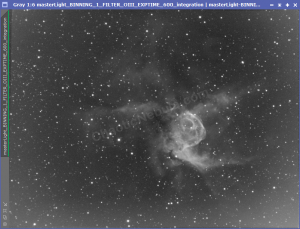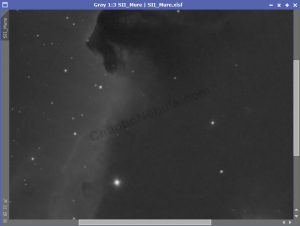Binning is a process of combining nearby pixels into a single, large pixel. On the plus side is you get a better signal to noise ratio (SNR). On the down side, you lose resolution.
Drizzle flips things around. It expands the resolution of the image by taking 1 pixel and expanding it into 2×2 pixels (of course there is a lot of math involved to make this work well). If your image is under-sampled (when you zoom in on a star, is it blocky?), drizzle can help smooth things out. Drizzle increases resolution but it also increases noise.
What would happen if I did a 2×2 bin and then did a 2×2 drizzle integration? The image resolution would be the same if I skipped both processes. But would the SNR be better? And would the image look better?
The Experiment
I ran through the PixInsight Weighted Batch Preprocessing script on the same set of data (12 images, 10 minutes each, through a hydrogen-alpha filter). The setup was as follows
- 2×2 binning, no drizzle
- 2×2 binning, 2×2 drizzle
- No binning, no drizzle
- No binning, 2×2 drizzle
The results are as follows (they are not in the correct order as the test cases). Pick 1, 2, 3, 4. Which is better?
If we zoom into a star, does your preference change?
Assessment
Based on my assessment, I came up with the following preferences
- Full Image: I think Option 3 and 4 look the best, but that is because there is more contrast.
- Zoomed Image: I think option 1 is the best, followed by 4. Option 4 is smoother than option 1, but the stars in option 4 are also bigger.
Results
I wanted some real numbers to associate with these images, so I used the PixInsight script Noise Evaluation on each full image. The results were as follows:
| Binning | Drizzle | Noise | Count (%) |
| 1×1 | No | 4.033e-01 | 73.18 |
| 1×1 | 2×2 | 2.973e-01 | 36.46 |
| 2×2 | No | 1.931e-01 | 29.54 |
| 2×2 | 2×2 | 1.369e-01 | 19.34 |
Based on the numerical analysis from the noise evaluation script, using a 2×2 bin with 2×2 drizzle had the least amount of noise in the samples. But does the data match the visual? Here are the results with the associated tests.
With the zoomed image, I picked option 1, which has the greatest amount of noise. I felt the details within the image were sharper than my second best result (option 4), which happened to be the image with the least amount of noise.
Caveats
A few notes about this test
- To do drizzle effectively, you need a lot of samples. My best results came from 50 or more images. In this scenario, I only had 12 images.
- Your results will differ based on your imaging equipment. But with the Weighted Batch Preprocessing script in PixInsight, running your own test is fast.









